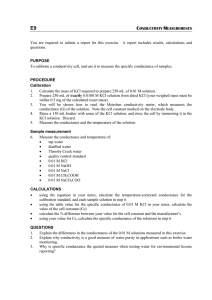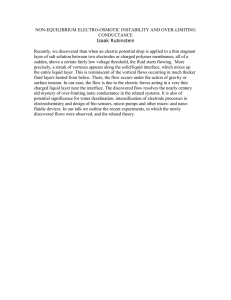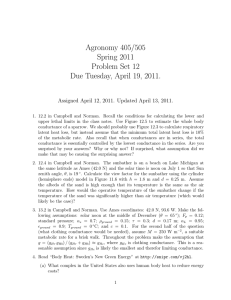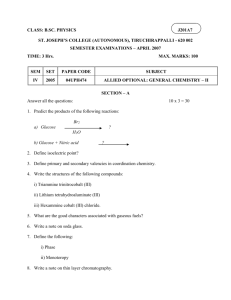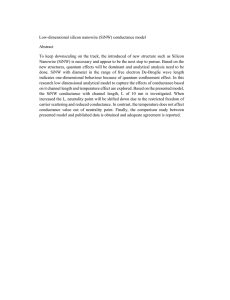Experiment 1
advertisement
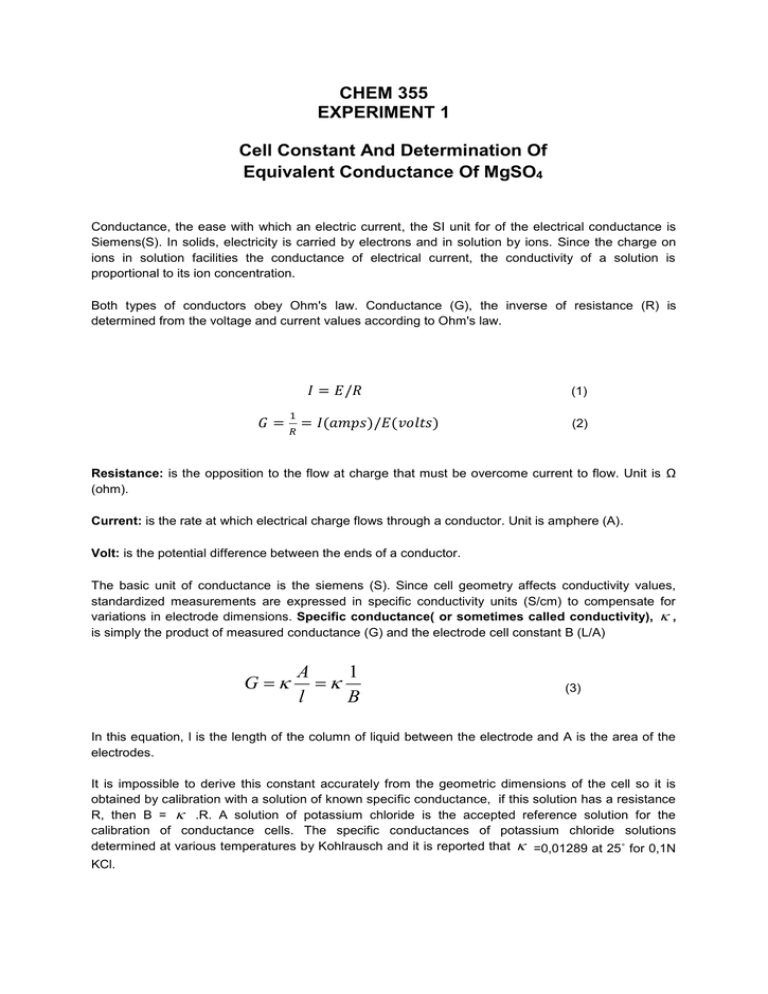
CHEM 355 EXPERIMENT 1 Cell Constant And Determination Of Equivalent Conductance Of MgSO4 Conductance, the ease with which an electric current, the SI unit for of the electrical conductance is Siemens(S). In solids, electricity is carried by electrons and in solution by ions. Since the charge on ions in solution facilities the conductance of electrical current, the conductivity of a solution is proportional to its ion concentration. Both types of conductors obey Ohm's law. Conductance (G), the inverse of resistance (R) is determined from the voltage and current values according to Ohm's law. 𝐼 = 𝐸/𝑅 1 𝐺 = 𝑅 = 𝐼(𝑎𝑚𝑝𝑠)/𝐸(𝑣𝑜𝑙𝑡𝑠) (1) (2) Resistance: is the opposition to the flow at charge that must be overcome current to flow. Unit is Ω (ohm). Current: is the rate at which electrical charge flows through a conductor. Unit is amphere (A). Volt: is the potential difference between the ends of a conductor. The basic unit of conductance is the siemens (S). Since cell geometry affects conductivity values, standardized measurements are expressed in specific conductivity units (S/cm) to compensate for variations in electrode dimensions. Specific conductance( or sometimes called conductivity), , is simply the product of measured conductance (G) and the electrode cell constant B (L/A) G A 1 l B (3) In this equation, l is the length of the column of liquid between the electrode and A is the area of the electrodes. It is impossible to derive this constant accurately from the geometric dimensions of the cell so it is obtained by calibration with a solution of known specific conductance, if this solution has a resistance R, then B = .R. A solution of potassium chloride is the accepted reference solution for the calibration of conductance cells. The specific conductances of potassium chloride solutions determined at various temperatures by Kohlrausch and it is reported that =0,01289 at 25˚ for 0,1N KCl. The specific conductance ( ) will clearly depend on the concentration of the electrolyte. In general, if the concentration doubles, the conductivity will double. The measurement of conductance is put on an per ion basis by defining the molar conductivity . c 1000 (4) The equation above is valid for both strong and weak electrolyte. When the value of Λ is extrapolated to zero concentration, equivalent conductance at infinite dilution is obtained. 0 k c (5) This equation defines molar conductivity and valid for only strong electrolyte where k is the experimental constant (do not confuse it with specific conductance, which is ). This linear relationship between Λ and √c is not the case in weak electrolytes solution because of degree of dissociation. In the weak electrolytes the degree of dissociation is not complete and expressed as: 0 (6) For weak electrolytes, teh equation below is used to calculate α and Kd. 2 c K d 0 0 (7) Apparatus and Chemicals Apparatus: Conductomete ,constant temperature water bath, tubes. Chemicals: KCl, MgSO4, Monochloroacetic acid. Procedure I. KCl solution 1. Prepare 0.1 M KCl solution (10 ml). 2. Put it in a constant temperature bath (25 0C) and wait to reach thermal equilibrium. 3. Wash the electrode with distilled water and dry. 4. Measure the conductance by using conductometer. II. Strong electrolyte ( MgSO4 solution) 1. Prepare 5 sets of MgSO4 solution in tubes (10 ml for each). 0.2 M, 0.1 M, 0.05 M, 0.025 M, 0.0125 M 2. Put them in a constant temperature bath (25 0C) and wait to reach thermal equilibrium. 3. Wash the electrode with distilled water and dry before each measurement. 4. Measure the conductance by using conductometer. 5. Start measurement with the most dilute solution. III. Weak electrolyte ( Monochloro acetic acid) 1. Prepare 6 sets of Monochloro acetic acid solution in tubes (10 ml for each). 0.1 M, 0.05 M, 0.03 M, 0.02 M, 0.01 M, 0.005 M 2. Put them in a constant temperature bath (25 0C) and wait to reach thermal equilibrium. 3. Apply the same procedure with part II and read conductance. (Waste container of experiment: sink container for MgSO4 solution and acid waste container for monochloroacetic acid.) Treatment of Data 1. Cell constant: Calculate the cell constant (B) by using recorded condactance data (G) and given . (Equation 3) 2. Conductivity calculations for MgSO4 Calculate the specific conductance and equivalent conductance for each solution. (Equation 3, Equation 4) Draw vs c graph to calculate the equivalent conductance at infinite dilution Λ0 . (Equation 5) 3. Conductivity calculations for Monochloroacetic Acid Calculate the specific conductance and equivalent conductance for each solution. (Equation 3, Equation 4) Draw Λc vs 1/Λ graph to calculate Λ0 and Kd. Then use equation 6 and equation 7 to calculate α and Kd. Questions 1. What is ostwald dilution law, explain briefly. 2. Write the factors which affect conductivity. 3. Why do we use KCl in this experiment? Could you suggest an alternative instead of KCl. 4. Why do we use equivalent conductace ( Λ) and specific conductance ( ) during these calculations instead of conductance (G). 5.Find Λ0 (theoratical) values from the literature and compare with your results. DATA SHEET Group Number: Experiment 1. Cell Constant and Determination of Eqiıvalent Conductance of MgSO4 Date: Assistant name and signature:
